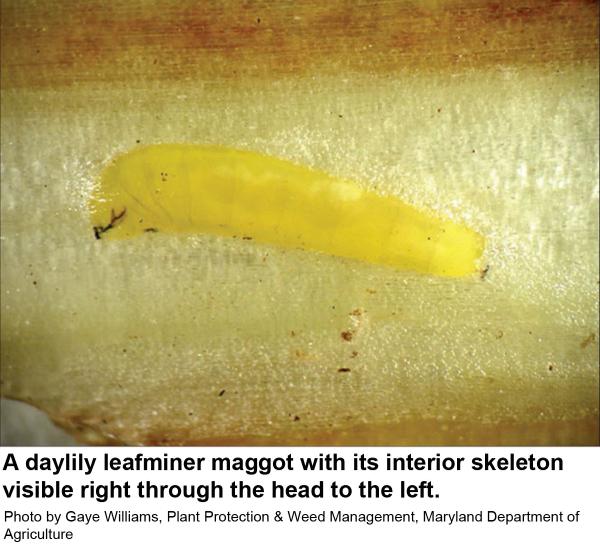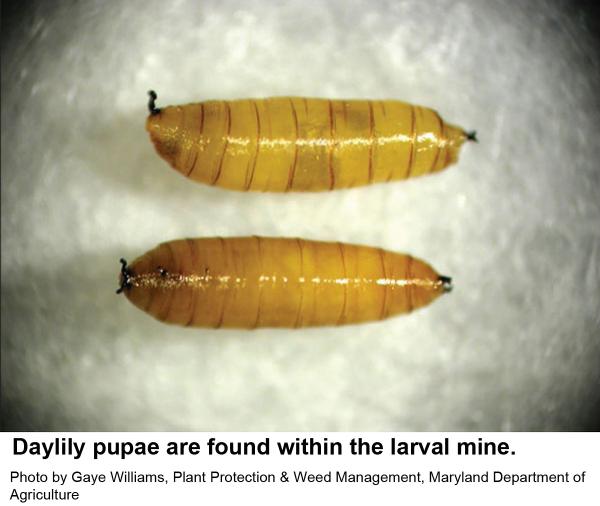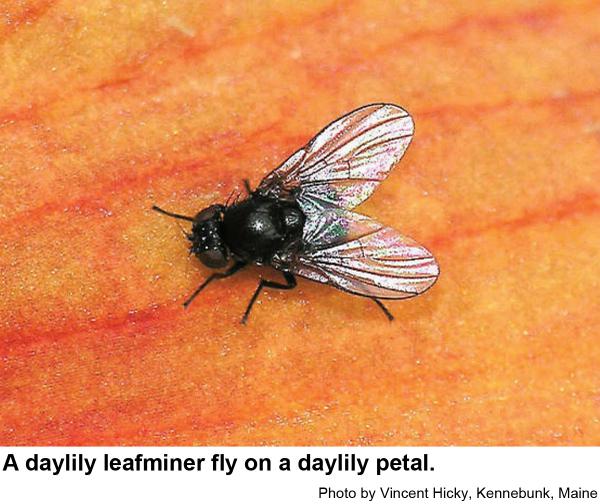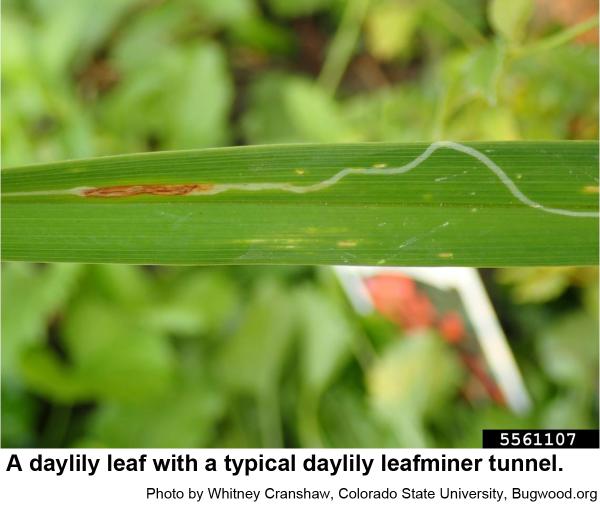Description and Biology
The daylily leafminer, Ophiomyia kwansonis, is a relatively new pest to North Carolina. This tiny, pale yellow maggot grows up to 3/16 inch long. With a handlens, it may be possible to see a black structure inside the head and two prominent black knobs (spiracles) on the thorax. The pupa is shorter and orange to brown with black spiracles on the thorax and rear. Daylily leafminer adults are tiny (about 3/32 inch long), black flies with dark red eyes and clear wings. Females insert eggs into the lower leaf surfaces – usually one per leaf and usually near the tip. Tiny maggots hatch and mine downward more or less parallel to the midrib. However with severe infestations of two or three or more maggots per leaf, the mines may zigzag, circle, or crisscross. We have at least three generations per year.
Host Plant
Daylily is the only host plant known for the daylily leafminer. Pale lines on the leaves are the first sign of daylily leafminers. The larva usually mines downward parallel to the midrib and pupates toward the base of the leaf. Infested leaves become unthrifty and may wither and remain disfigured for the rest of the growing season.
Residential Recommendations
The daylily leafminer is primarily a nuisance pest of daylilies. Except perhaps with extreme infestations, this pest does little actual harm to the health of infested plants. Leafminers in general are plagued with tiny parasitic wasps. After the initial alarm of discovering daylily leafminers in the landscape, if one can refrain from applying an insecticide, the population will probably die away gradually. Systemic insecticides such as imidacloprid can be applied to the leaves or soil beneath infested daylilies to control daylily leafminers (however, damaged leaves will not improve in appearance after treatment). One problem with using imidacloprid is that spider mites may suddenly flair up, so keep an eye on treated plants to prevent spider mites from causing even worse damage.
Other Resources
- A Study of the Japanese Agromyzidae (Diptera), Part 2. Sasakawa, M. 1961. Pacific Insects 3 (2-3): 307-472.
- Daylily Leafminer, Ophiomyia kwansonis Sasakawa (Diptera: Agromyzidae), new to North America, including Florida. Steck, G. J. 2012. Florida Dep. Agr. Consumer Services, Div. Plant Indust. DACS-P-01807
- Daylily Leafminer, Ophiomyia kwansonis Sasakawa, Newly Identified in North America. Williams, G L. and G. J. Steck. 2011. National Plant Diagnostic Network News. 6 (9): 2-3.
- Twospotted Spider Mites on Landscape Plants. Frank, S. 2009. NC State Extension Publications, Entomology Insect Notes.
- Extension Plant Pathology Publications and Factsheets
- Horticultural Science Publications
- North Carolina Agricultural Chemicals Manual
For assistance with a specific problem, contact your local N.C. Cooperative Extension Center.
This Factsheet has not been peer reviewed.
Publication date: Dec. 1, 2018
Revised: Sept. 13, 2023
Recommendations for the use of agricultural chemicals are included in this publication as a convenience to the reader. The use of brand names and any mention or listing of commercial products or services in this publication does not imply endorsement by NC State University or N.C. A&T State University nor discrimination against similar products or services not mentioned. Individuals who use agricultural chemicals are responsible for ensuring that the intended use complies with current regulations and conforms to the product label. Be sure to obtain current information about usage regulations and examine a current product label before applying any chemical. For assistance, contact your local N.C. Cooperative Extension county center.
N.C. Cooperative Extension prohibits discrimination and harassment regardless of age, color, disability, family and marital status, gender identity, national origin, political beliefs, race, religion, sex (including pregnancy), sexual orientation and veteran status.





